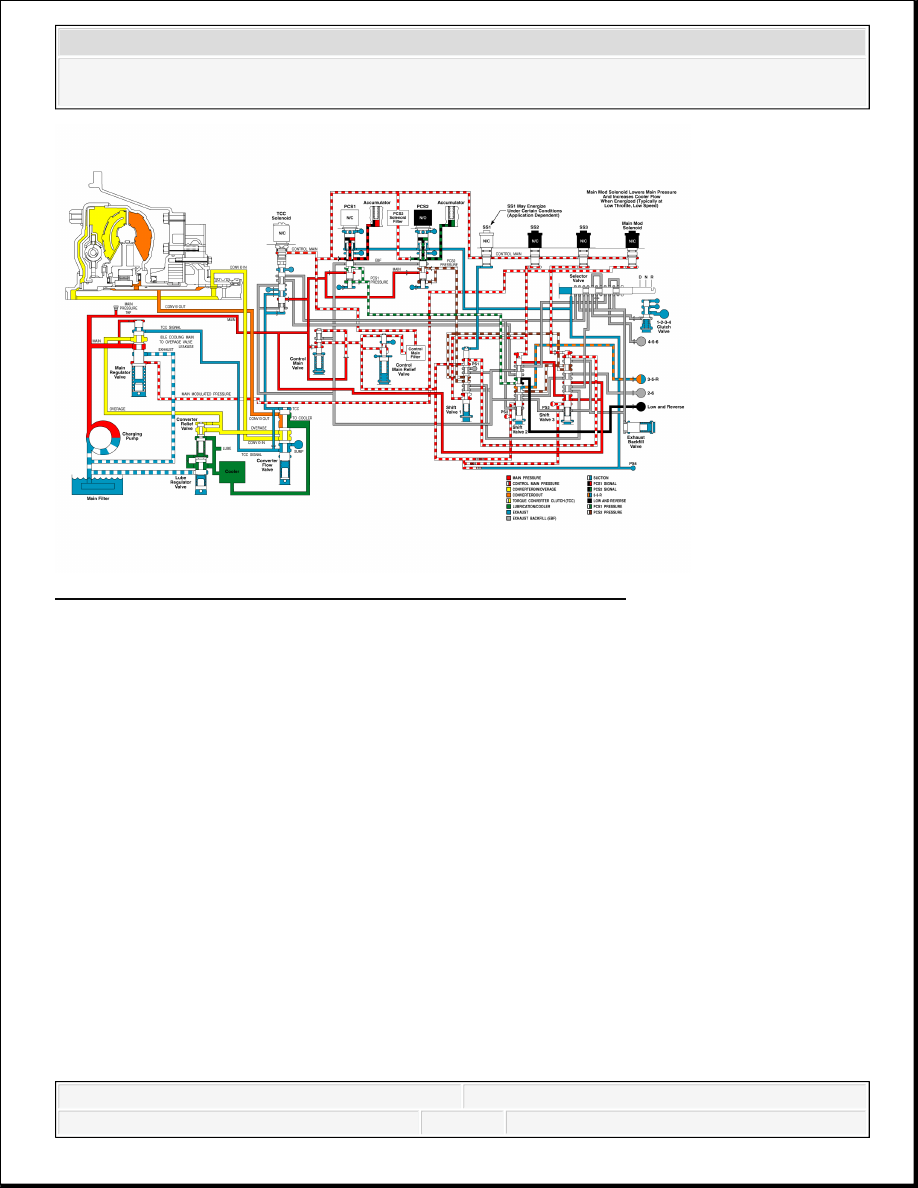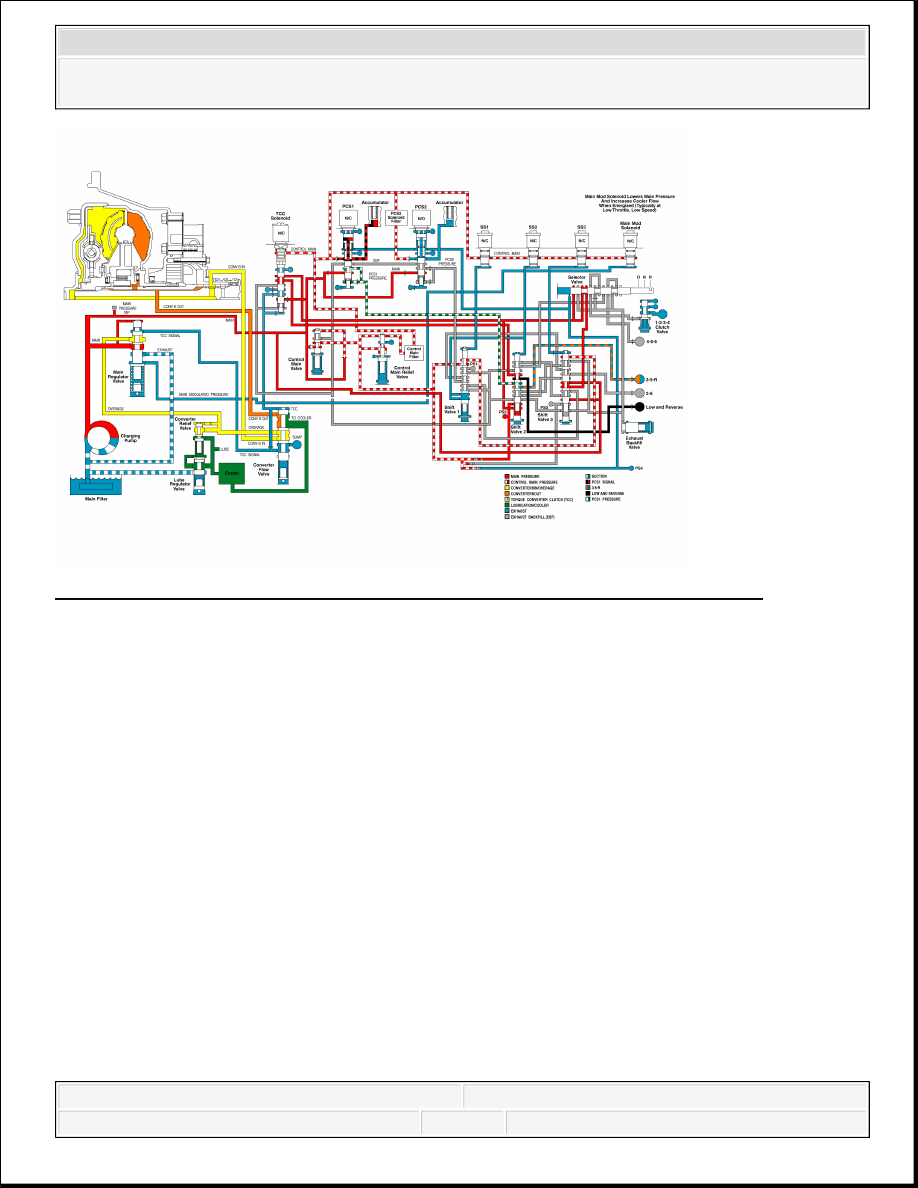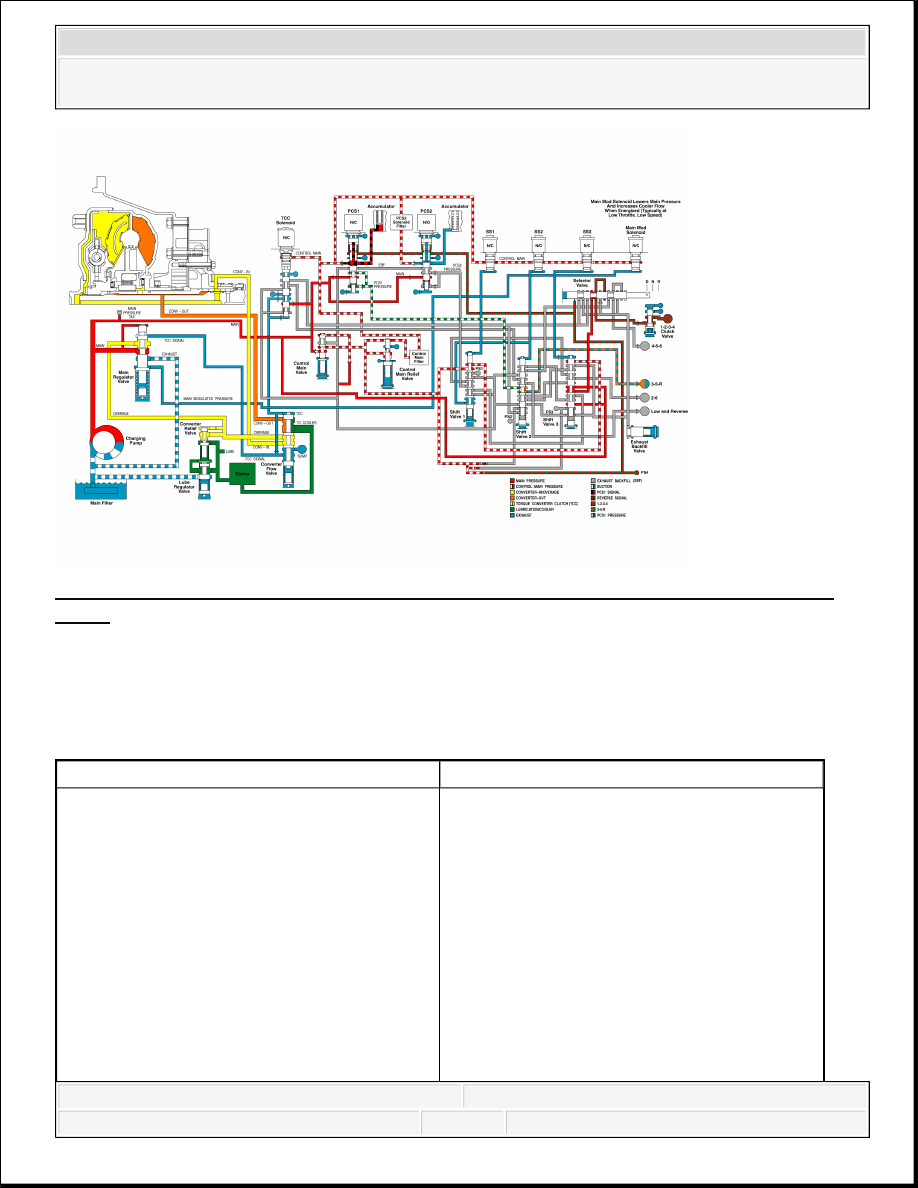Content .. 1003 1004 1005 1006 ..
Chevrolet Silverado / GMC Sierra. Manual - part 1005
signal pressure increases, the PCS2 pressure increases. The PCS2 signal pressure also acts on the
gain valve, stroking the valve and compressing the gain valve spring. When the gain valve spring
is compressed sufficiently, the gain valve contacts pressure control valve 2. The gain valve spring
allows the 3rd, 5th, and reverse clutch initial apply to be controlled at a lower gain rate,
improving control of the oncoming 3rd, 5th, and reverse clutch. Once the gain valve makes
contact with pressure control valve 2, PCS2 pressure increases at a higher gain rate, PCS2
pressure flows through shift valve 1 to shift valve 3 and on to apply the 3rd, 5th, and reverse
clutch. When the shift to reverse is complete, PCS2 fully energizes and PCS2 pressure fully
applies the 3rd, 5th, and reverse clutch. PCS1 supplies full pressure to the low and reverse clutch.
The application of the 3rd, 5th, and reverse clutch and the low and reverse clutch produces
reverse range operation.
If electrical power is interrupted with the transmission operating in reverse range, PCS2, SS2,
and SS3 de-energize. When PCS2 de-energizes, the normally open solenoid exhausts PCS2 signal
pressure, causing pressure control valve 2 to de-stroke, exhausting and releasing the 3rd, 5th, and
reverse clutch. Shift valve 1 remains in the stroked position. Control main pressure goes through
shift valve 1 to the top of shift valve 3 keeping shift valve 3 stroked. Normally closed PCS1
blocks the exhaust of PCS1 signal pressure, and PCS1 pressure is maintained. PCS1 pressure
continues to be directed through shift valve 2, which stays down due to the "latching" effect of
pressure on two different diameter lands, to the low and reverse clutch, keeping the low and
reverse clutch applied. Because only one clutch is applied, the transmission shifts to neutral range.
If electrical power is interrupted with the transmission operating in reverse range, resulting in
neutral operation, main pressure is directed through shift valve 3 to shift valve 2. Because shift
valve 2 stays stroked due to the "latching" effect of pressure on two different diameter lands,
main pressure is blocked from reaching the manual selector valve. If the manual selector valve is
moved to Neutral (N) or a forward range, the transmission remains in neutral.
If electrical power is interrupted with the transmission operating in reverse range, resulting in
neutral operation, the engine may be shut down and restarted to attain neutral, third and reverse
operation.
2008 Chevrolet Silverado 1500
2008 TRANSMISSION Automatic Transmission - Allison - Cab & Chassis Sierra, Cab & Chassis Silverado, Sierra &
Silverado

Fig. 530: Identifying Hydraulic Circuits Used In Reverse Range
Courtesy of GENERAL MOTORS CORP.
DEFAULT REVERSE - LIMP HOME
If electrical power is interrupted with the transmission operating in reverse range, resulting in
neutral operation, main pressure is directed through shift valve 3 to shift valve 2. Because shift
valve 2 stays stroked due to the "latching" effect of pressure on two different diameter lands,
main pressure is blocked from reaching the manual selector valve. If the manual selector valve is
moved to Neutral (N) or a forward range, the transmission remains in neutral.
If electrical power is interrupted with the transmission operating in reverse range, resulting in
neutral operation, the engine may be shut down and restarted to attain neutral, third and reverse
operation.
2008 Chevrolet Silverado 1500
2008 TRANSMISSION Automatic Transmission - Allison - Cab & Chassis Sierra, Cab & Chassis Silverado, Sierra &
Silverado

Fig. 531: Identifying Hydraulic Circuits Used In Default Reverse - Limp Home
Courtesy of GENERAL MOTORS CORP.
DEFAULT FORWARD - 3RD RANGE LIMP HOME
If electrical power is interrupted while the transmission is in third range, SS1 and the torque
converter clutch (TCC) solenoid (if TCC is applied) are de-energized. Shift valve 1 de-strokes,
changing the exhaust path of the 4-5-6 clutch to exhaust backfill and the exhaust path of the 2-6
clutch to pressure control valve 2. Normally closed PCS1 continues to block the exhaust of the
PCS1 signal pressure (signal remains control main). The signal pressure on top of pressure control
valve 1 produces maximum PCS1 pressure, which is routed through shift valve 2 to the 3rd, 5th,
and reverse clutch, keeping the clutch applied. With the manual selector valve in a forward
position, main pressure continues to feed the 1-2-3-4 clutch through shift valve 3 and the manual
selector valve. The combination of the 1-2-3-4 clutch and the 3rd, 5th, and reverse clutch applied
keeps the transmission in third range for limp home capability. If the TCC is applied, the TCC
solenoid de-energizes, causing the TCC valve to de-stroke, exhausting pressure from the top of
the converter flow valve. The converter flow valve de-strokes, redirecting main overage to
converter in and converter out to the cooler. The TCC is now released.
2008 Chevrolet Silverado 1500
2008 TRANSMISSION Automatic Transmission - Allison - Cab & Chassis Sierra, Cab & Chassis Silverado, Sierra &
Silverado

Fig. 532: Identifying Hydraulic Circuits Used In Default Forward - Third Range Limp
Home
Courtesy of GENERAL MOTORS CORP.
SPECIAL TOOLS AND EQUIPMENT
SPECIAL TOOLS
Illustration
Tool Number/ Description
Scan Tool
2008 Chevrolet Silverado 1500
2008 TRANSMISSION Automatic Transmission - Allison - Cab & Chassis Sierra, Cab & Chassis Silverado, Sierra &
Silverado
Content .. 1003 1004 1005 1006 ..